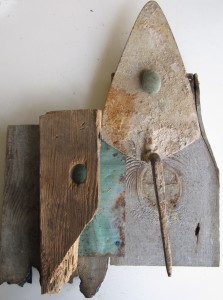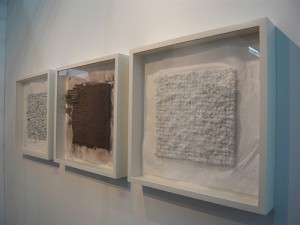Art Home
Last night I had three dreams about houses. This is not uncommon. I often dream about structures and cubic spaces and the things that go on in them. One of my dreams was oppressive. In another my mother appeared and I asked her for advice. The last one delighted me so much that I was still flashing back to it over breakfast. In it I was standing in a room, looking through a big square window at the glint off the water and the trees outside, when the view began to move, and I realized it was a floating house, floating away. It left me with a great sense of freedom and adventure.
Lots of my time is occupied with buildings and rooms. For much of my adult life I’ve been rehabbing my farmhouse. Lately I’ve been deconstructing my chicken coop and smokehouse, both of which had begun to droop and sag like giant organic forms. Rather than have them knocked down by a bulldozer I, my sons, and our helper have been taking them apart board by board. En route to the dump I began to recognize beauty in bits and pieces of the scrap. I found little archeological fragments in the dirt of the foundations—bits of my grandmother’s everyday china, early pottery shards, toys my children dropped, hardware from jobs their father had tackled. This so intrigued me that I set up a screen for sifting the soil in order to capture what might be hiding there.
Concurrently I was teaching my Intro to Sculpture students about the trash collages of Kurt Schwitters in the years between the wars. I recalled for them my first live exposure to one of his pieces. I described for them how, at the Tate Modern, I was surrounded by Rothkos and huge Pollocks. A Water Lily hung there, and many other great iconic works, but what riveted me were the tiny playing card sized collages of Schwitters. They were indescribably elegant. Their composition locked together with complete certainty. I still recall the surface texture and subtle coloration of those pieces. It finally occurred to me that I should allow myself to be inspired by Schwitter’s example and create some assemblages using my bits and pieces, charged as they were with their layers of meaning and history. Thus was born the Chicken Coop Series.
For me, the sculpting experience is a bit like standing in a room that one suddenly realizes is moving—shifting from the 2-D work I’m so accustomed to, and into this formal exploration of three dimensionality. It’s loaded with adventure. I labored for days over the arrangement of the first piece, then more quickly put together the second and third and fourth. When I set them up to study them, the weakest was that first tentative effort. As I go forward they become more aggressive with space, and I hope, lock together in relationships that seem meant to be.
Best of all I like that some fragment of the past utility and dailiness of those two old structures is brought forward into the utility and dailiness of the life of the farm today. The farm is no longer a place where hams are smoked and chickens are laying. Instead, it is a place where art hovers always a bit above our heads, or lurks buried in the soil, or shows up in time for talk around the dinner table, or stands with us as a comfort in times of confusion and loss. When Stewart was about five he made a drawing for me. It was of a boat, rocking on the ocean. High up on its mast it flew a flag that said “Art Home”.





Recent Comments